Join us at the Hynes Convention Center in Boston, Massachusetts November 8-10, for the 46th Boston International Antiquarian Book Fair!
With more than 100 rare book dealers from the Czech Republic, Denmark, France, Italy, Netherlands, Serbia, the UK, and 19 U.S. states, an alluring treasure trove awaits seasoned bibliophiles and first-time attendees at the Fair. Here is a small selection of items to preview the treasures you will find in Boston.
Original Artwork by the "Painter of the Revolution"
John Trumbull: ORIGINAL PEN AND INK CHARACTER STUDY FOR HIS PAINTING, Priam Returning to his Family the Dead Body of Hector, DEPICTING A GROUP OF FIVE DISTRAUGHT TROJAN MOURNERS. London.: December 22, 1784
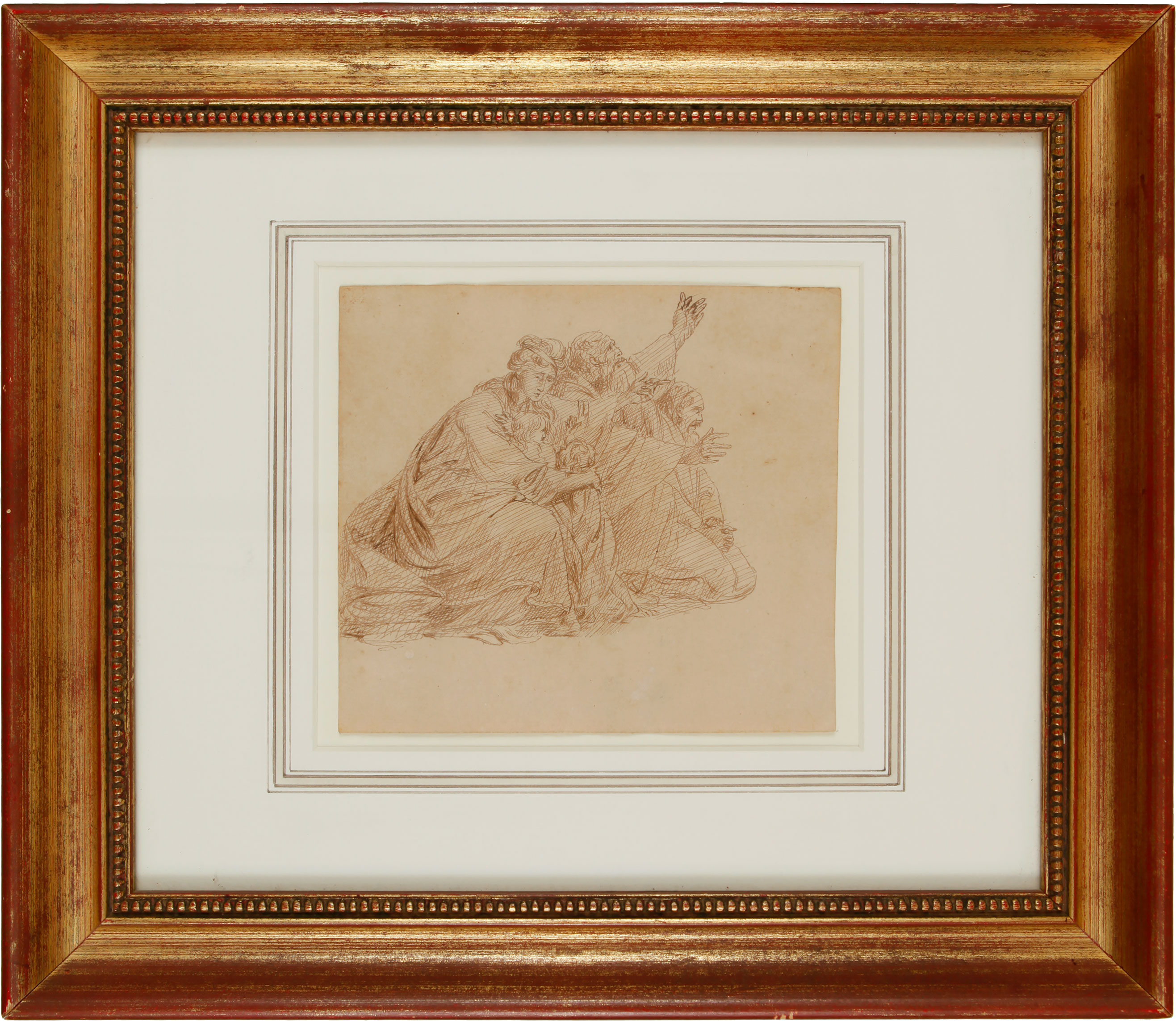
5¾ x 6½ inches (14¾ x 16½ cm). Light tanning, some old creases to the paper. Near fine. Matted and framed.
$25,000.00
A vibrant and kinetic character study accomplished relatively early in the career of the renowned American painter John Trumbull, in preparation for one of his rare mythological scenes. The present drawing was done by Trumbull during his second visit to London, while studying in Benjamin West's studio. Signed and dated "London Dec 22d 1784" on the verso, it is a study for the following year's large-scale painting titled Priam Returning to his Family the Dead Body of Hector, one of the artist's only major works on a mythological topic. The group studied here, comprising five Trojan mourners including a woman with her two small children, appears on the left side of the final painting.
Few authentic works by Trumbull remain in private hands: the artist himself sold the vast majority of his personal collection to Yale in 1831, which served as the basis for the Yale University Art Gallery. Most of the remainder passed to famed Yale professor Benjamin Silliman, and were sold at a Thomas Birch's Sons auction in 1896. The greatest part of these quickly found their way to permanent institutional homes as well, primarily Yale, Fordham, Princeton, and the Met. The present work has never left the Trumbull family, and passed down from the artist's brother, David Trumbull, through direct descent to the noted collector Col. Ralph Heyward Isham, thence to his son Jonathan Trumbull Isham, and from him to the consignors.
Offered by William Reese Company, booth 210.
Kerouac, Jack. Original Illustrated Typescript Story, with Typed Letter, Signed ("Jack K."), to Mrs. A. B. Chandler ("Dear Mrs. Chandler"), dated April 12, 1950.
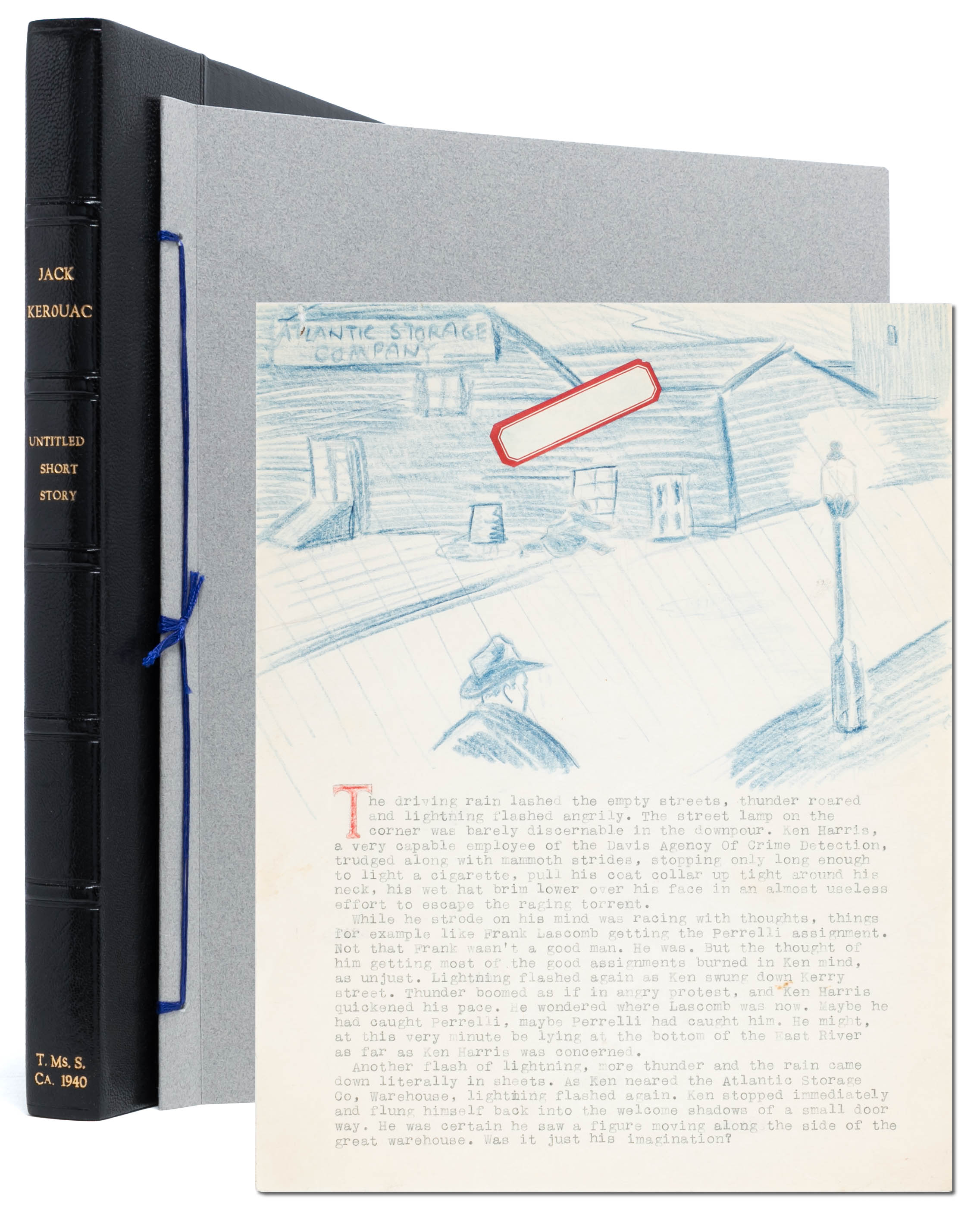
Lowell, MA: c. 1938.
$35,000
Original typescript by Jack Kerouac, a previously unknown story written and illustrated when he was just 16, with a letter signed by Kerouac to the mother of his childhood friend.
Offered by Whitmore Rare Books, booth 505.
BARTISCH, Georg. Ophthalmodouleia
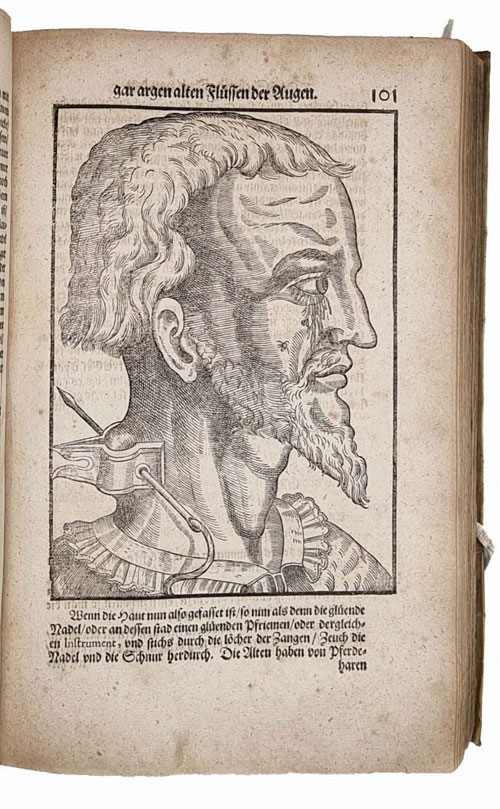
Dreseden, durch Matthes Stöckel, 1583.
£75,000.00
FIRST EDITION. ff. (xxviii), 274, (viii). Gothic letter, little Roman and Greek. T-p in red and black within decorated woodcut border with grotesques, arms of Saxony and Dresden, repeated on C1, text within woodcut antique-style frames to C1 verso, very large woodcut arms of Duke August Elector of Saxony to A2, ½-page woodcut arms of Dresden to E3 verso, full-page woodcut author’s portrait to E4 verso. 88 handsome full-page woodcuts (with 11 paper overlays) of eye conditions, eye treatments (including spectacles), the body in relation to Zodiac, and utensils to produce and contain medicaments, decorated initials and ornaments. Uniform slight browning (low-quality paper), occasional very minor marginal foxing, minimal offsetting from woodcuts, small iron clips (bookmarks) to a dozen outer edges. A very good copy in contemporary vellum, yapp edges, two leather ties (renewed), raised bands, title inked to spine, old shelfmark label, small ink stain to upper edge of upper cover. Ms. ‘Sum And. Laubmarij I.V.D. [Iuris Utriusque Doctor] Emptus 1583’ and ‘H.H.H. Lundsgaard Kobenhavn 1921’ to front pastedown, C19 stamps of University of Tubingen and ‘Verkauft Doubl(?)’, and C16 ms. ‘88 pge. 155 bge. 3/30’ to t-p, one affecting two letters, the odd contemporary ms. note, C19 bibliographic inscription at foot of t-p blank verso, another to rear fep.
A very good copy of the first edition of this exceptional and ground-breaking medical book—the first on eye surgery and the first ophthalmic book in the German language. It provides the first comprehensive view of Renaissance eye surgery. Georg Bartisch (1535-1607) started his career as an itinerant surgeon in Saxony, Bohemia and Silesia. Having settled in Dresden, he became renowned for his surgical techniques to treat cataract and remove eye cancers; he used his vast experience to write ‘Ophthalmodouleia’. These achievements earned him the post of oculist to Duke Augustus I of Saxony, to whom the work is dedicated. Only 3 works on ophthalmology had been published before Bartisch’s, and none so lavishly illustrated. The woodcuts, probably sketched by Bartisch himself, were cut by Hans Hewamaul. ‘Two of the woodcut illustrations were produced with overlays showing anatomical parts lying successively one under the other. […] Bartisch was the first to illustrate the brain and the eye in this manner’ (Albert, ‘Introduction’, ii). The 13 chapters span the anatomy of the head and eye, eye conditions and their surgical treatments (with special attention to the five different kinds of cataract—Bartisch’s specialism), as well as pharmacopoeia. Very interesting are the sections devoted to strabismus and the ‘squint mask’—a medical instrument first mentioned in writing in the 7th century—covering the head and face in different ways (even with funnels around the eyes), according to the type of strabismus. Along state-of-the-art surgical techniques, a few sections reveal the unexpected role which superstition and popular religion played in Bartisch’s overall understanding of disease and cure. Two large woodcuts show handsomely portrayed amulets to be worn, round the neck, by people suffering from weak sight; among these are a heart with a crucifix, a pendant with a serpent wrapped around a cross, and a small book. A fascinating detail shedding light on the ‘marketing’ of early modern medicine is found in two woodcuts portraying a pair of pliers which can be used to ‘stamp’ the doctor’s name onto little ‘cakes’ used to administer medications. A most attractive medical work, with unusual illustrations.
This copy was purchased soon after its publication by Andreas Laubmar (or Laubmaier, fl. late C16/early C17), professor of law at Tubingen and councillor to the Duke of Wurttemberg.
Garrison-Morton (3rd ed.), 5817; Heirs of Hippocrates 369; Wellcome I, 697 (incomplete); Durling 479.
Offered by Sokol Books, booth 513.
RIDGWAY, Robert. Color Standards and Color Nomenclature … With Fifty-three Colored Plates and Eleven-Hundred and Fifteen Named Colors. Washington, D. C. 1912. Published by the Author.
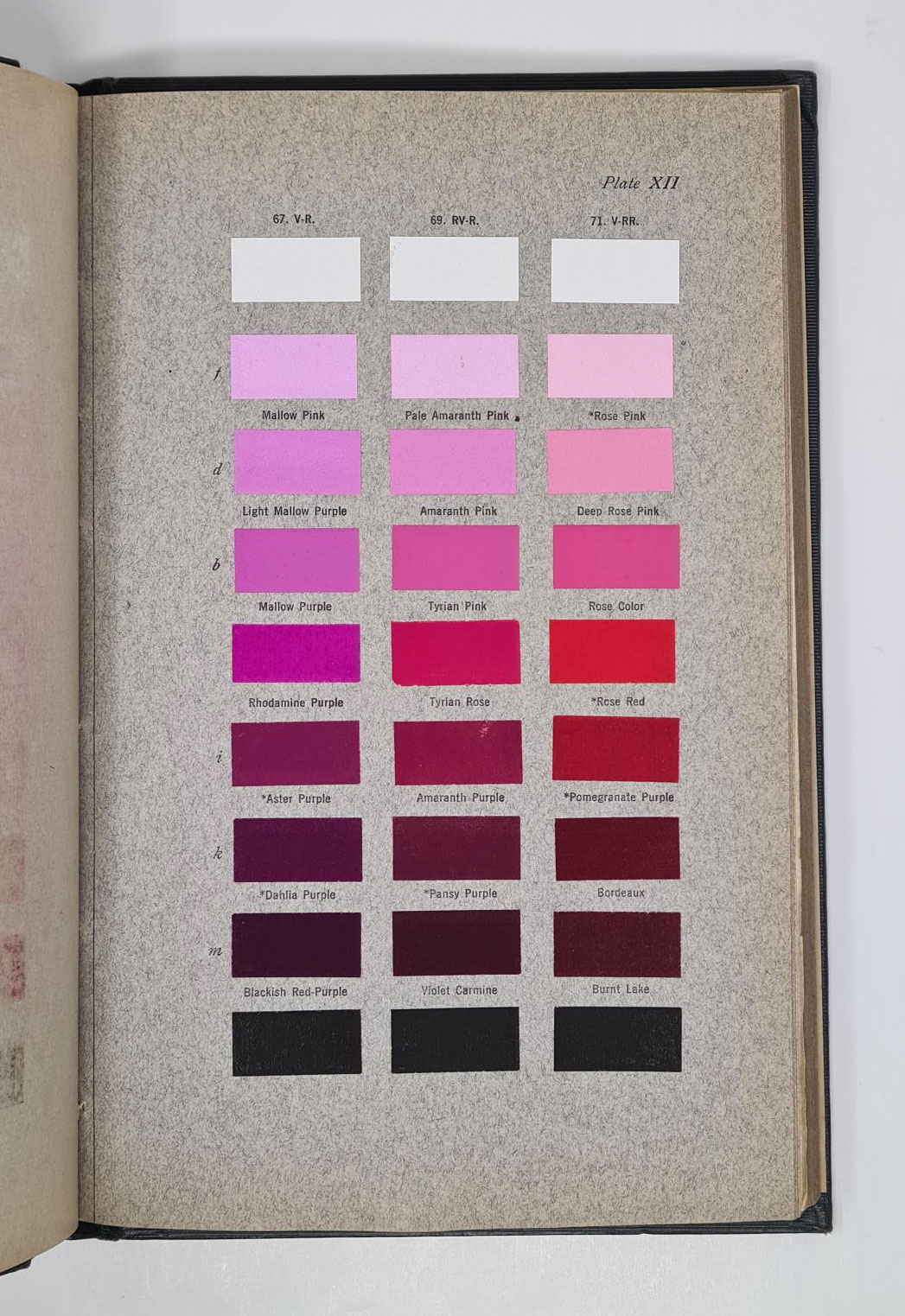
8vo (224 × 148 mm), pp. [4], iii, [1], 43, [1]; with a colour-printed front cover/additional title and 53 plates; printed slip (‘Explanation of Plates XXII and XXIV’) loosely inserted; original green ribbed cloth lettered gilt, light wear at extremities of spine, slight mark to rear cover, hinges reinforced with cloth tape, ink ownership inscription of Beatrice B. Law, Aberdeen, dated 1933, to front free endpaper.
£500
First edition. ‘Desirous for a book that would finally standardize colors and their names, Robert Ridgway [1850–1929], an ornithologist, took upon himself the mammoth task of producing just such a volume – covering more than a thousand colors. The enduring value of his labor is evidenced by the naturalists and artists who, a century later, continue to use it as a standard reference. Much of this value must certainly lie in the work’s impressive display of color itself: distributed among 53 plates is a true sample for every one of the 1,115 colors Ridgway has named.
‘The challenge of producing stable true color samples for publication is daunting’ and a printed note on the page before the plates reads ‘Caution!!! Do not expose these plates to the light for a longer time than is necessary’. Previous owners of the present copy have certainly heeded this and the colours are still vibrant and bright.
‘Perhaps even more daunting, however, is the challenge of imposing standard naming conventions on colors that have already been marketed under countless proprietary names. “Most of them are invented,” Ridgway writes of trade names of colors, “apparently without care or judgment, by the dyer or manufacturer of fabrics, and are as capricious in their meaning as in their origin; for example: such fanciful names as ‘zulu,’ ‘serpent green,’ ‘baby blue,’ ‘new old rose,’ ‘London smoke,’ etc., and such nonsensical names as ‘ashes of roses’ and ‘elephant’s breath.’” This sort of confusion no doubt continues today – you need only consult a box of crayons – but Ridgway’s work paved the way for the recourse found in today’s international color standards’ (MIT Libraries blog, ‘150 Years in the Stacks’, 27 Feb. 2011).
Offered by Simon Beattie Ltd., booth 425.
De Pollutione Nocturna
by Jean Gerson
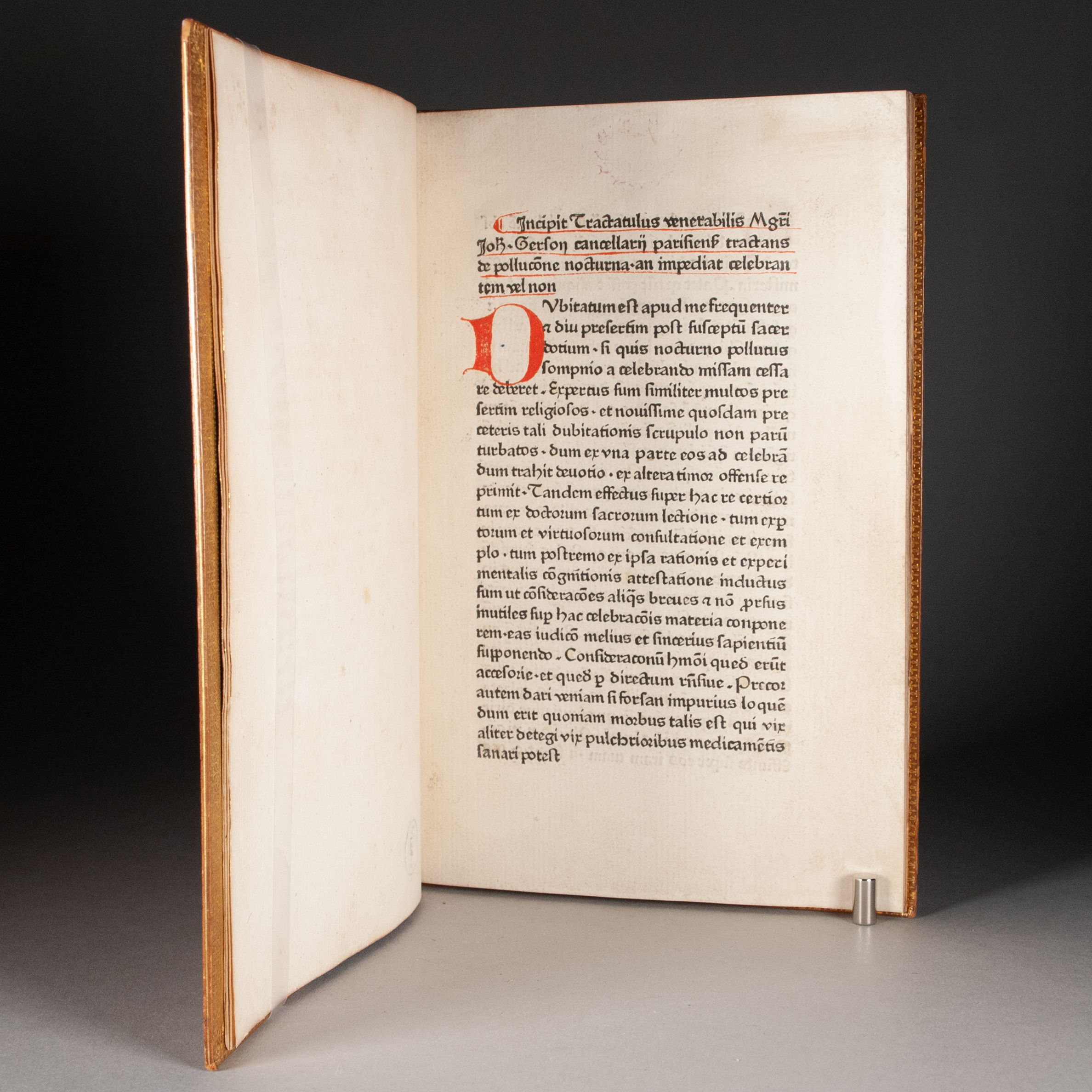
Cologne: Ulrich Zel, about 1469-1472.
Perhaps the fourth edition of this work on nocturnal emissions, its first edition often cited as the first printed work of medical interest. This edition likely appeared 1469-1472, making it very early for work bearing on medicine and sexuality. We find few earlier such works at auction, most of them at least a generation behind us.
Offered by Patrick Olson Rare Books, booth 213.
A Dutch lottery set.
_%20.png)
18th. No single man on its own is depicted, only women, (with their lovers).
Offered by Konstantinopel Rare & Fine Books, booth 226.
Robert Bloch
Psycho

First Edition/First Printing; A Near Fine book in a Near Fine dust jacket. SIGNED by the author. A beautiful copy of this classic of horror fiction and basis for the seminal movie; Scarce signed. $4000
Offered by Grayshelf Books, booth 516.
Strength to Love by Martin Luther King, Jr.
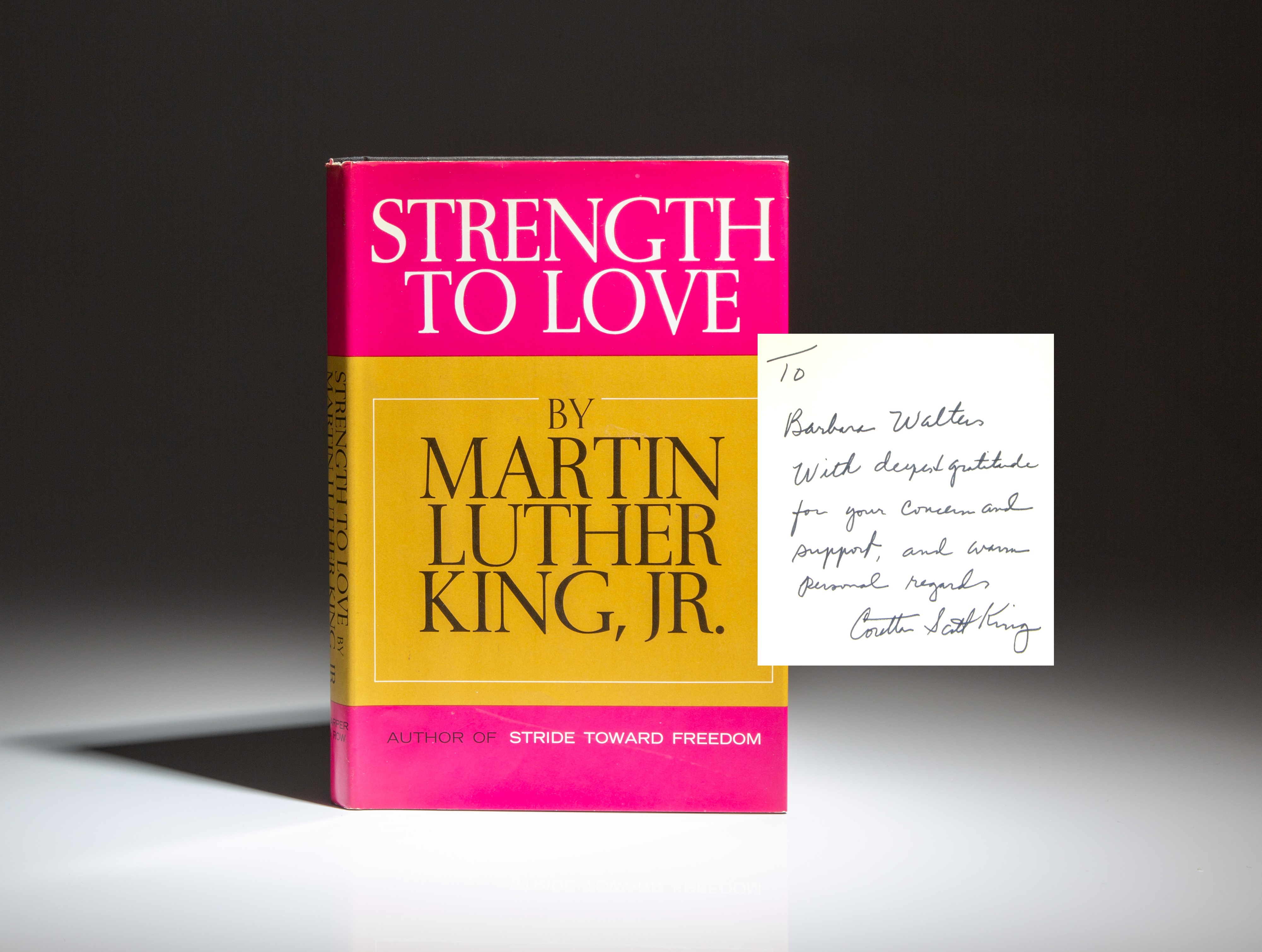
Inscribed by his wife, Coretta Scott King for Barbara Walters, in 1970. $1,850
Offered by First Edition Rare Books, booth 504.
The Holy Bible, Conteyning the Old Testament and the New. Newly Translated Out of the Originall Tongues: And with the former translations diligently compared and revised, by his Maiesties Speciall Comandement…
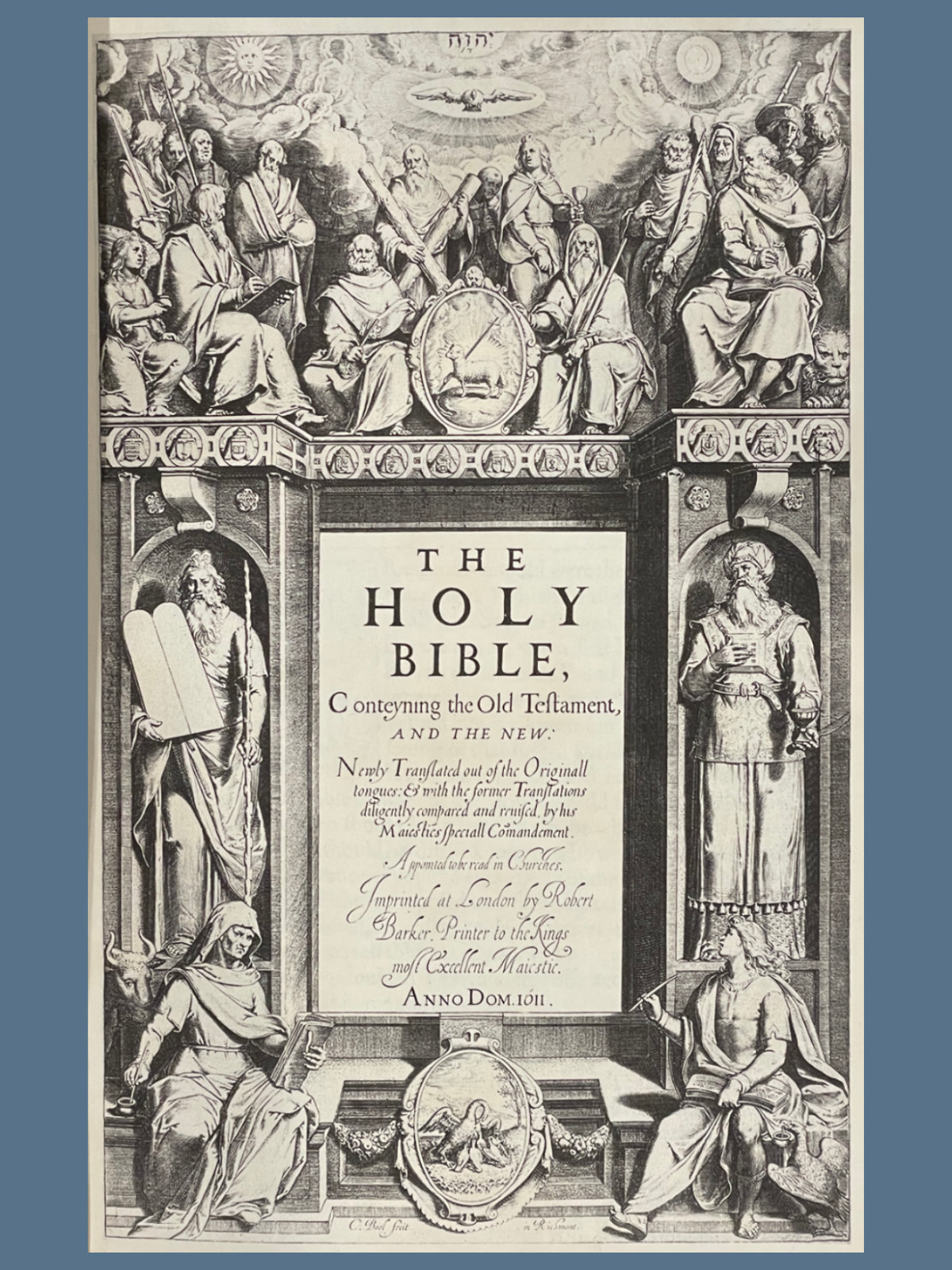
Summary
The editio princeps of the King James Bible – the crowning jewel of English Bible versions and one of the most important books in all literature.
Description
General title page in facsimile. Calendar printed in red and black. Text in large two column black letter type with 59 lines to the full column and within a ruled border. With the reading “and he went into the citie” in Ruth 3:15. New Testament title page (1611) with the twelve tribes of Israel on the left and the twelve disciples on the right. The four evangelists with their gospel symbols around the letterpress with the Tetragrammaton, the dove, and the slain Lamb at the center. Woodcut initials, head- and tailpieces throughout.
Collation
A^6, B^2 [-A^6, General title and first five preliminary leaves in facsimile], C^6 [Calendar], D^4 [-D1, Tables with first leaf in facsimile], A-C^6 [-A1, Genealogies with title page in facsimile], D^2 [Double-page map in facsimile]; A-Z^6, Aa-Zz^6, Aaa-Zzz^6, Aaaa-Zzzz^6, Aaaaa-Ccccc^6 [Old Testament and Apocrypha]; A-Z^6, Aa^6 [New Testament]. Complete Bible text with eight preliminary leaves and the map supplied in facsimile.
Binding
Rebound in two-toned black and brown paneled calf. Boards ruled and rolled in blind around a central lozenge. Spine with five raised bands and elaborate blind-tooling to compartments with two gilt-lined red morocco labels and the words “Holy Bible” and “1611” lettered in gilt. New plain endpapers.
Condition
Preliminaries stained to third of text, gradually decreasing through Genealogies until it fades away in Genesis; B1-C2 of prelims remargined; R1,R3 (Deut 2-5) loss to foot with the few missing words replaced in facs; R4 (Deut 6-7) loss of a few verses to outer column replaced in facs; Ssss3 repaired closed tear through text without loss; I2-6 closed tear repaired to lower margin; P6 (Rom 13) lower corner repaired without loss; T1 small repair to lower corner with few missing words replaced in facs; Aa1-4 (Rev 8-16) lower and upper corner repaired with portion of headline replaced in facs; Aa5-6 (Rev 16-22) margin and portions of gutter repaired with missing portions replaced in facs; soiling to final few leaves; some lower corner folds toward the end of the New Testament; generally a clean, crisp, and bright copy.
Note
Arguably the most important book ever published in English in one of only two hundred surviving copies. Its influence can best be summed up by G.M. Trevelyan who stated that "for every Englishman who had read Sidney or Spenser, or had seen Shakespeare acted at the Globe, there were hundreds who had read or heard the Bible with close attention as the words of God. The effect of the continual domestic study of the book upon the national character, imagination and intelligence for nearly three centuries to come, was greater than that of any literary movement in our annals, or any religious movement since the coming of St. Augustine." Macaulay said of it, “If everything else in our language should perish, [the King James Bible] would alone suffice to show the whole extent of its beauty and power” (PMM 114).
References
Herbert 309; STC 2216; ESTC S122347; PMM 114. Brake-Hellstern Census of He Bibles # BHC-300.
$175,000.
Offered by Dungeness Books, booth 116.
FREE SPEECH!!
Banned in Boston, The Actual Trial Exhibit Copy of Lady Chatterley’s Lover Used to Convict Boston Bookseller James A. DeLacey for Obscenity
Lawrence, D.H. Lady Chatterley’s Lover.
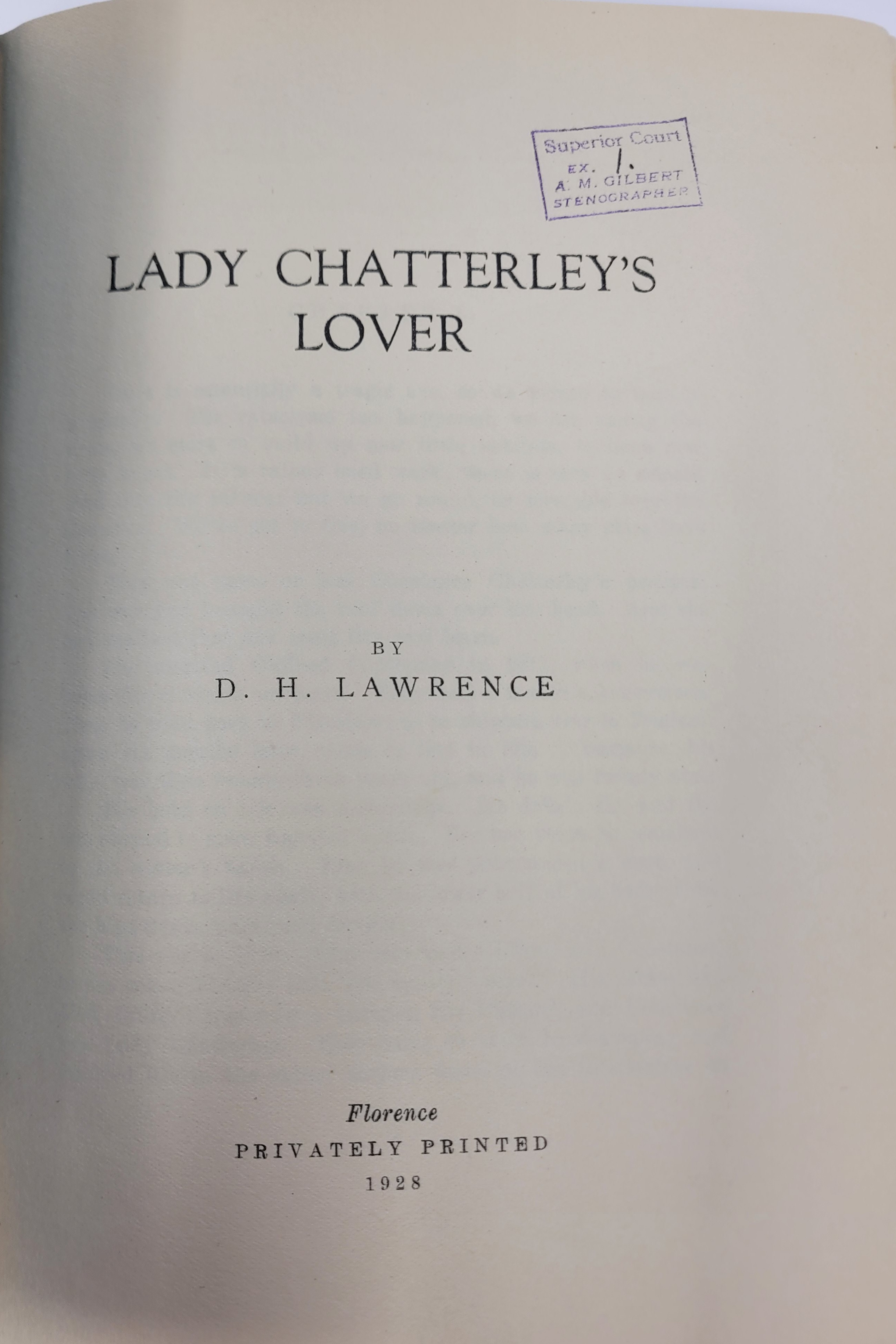
Florence: Privately Printed, 1928. 365 pp. Spine lacking, lower corner of page one is lacking, edges of the boards are worn, preliminary page opposite the title page lacking, stamped and manuscript markings of the Superior Court identifying this copy as evidence. A pirated copy circa 1929?
This copy was used to entrap and convict Boston Bookseller James A. DeLacey for Obscenity. Delacey owned Dunster House Books in Cambridge and was entrapped in a sting. The copy has two manuscript notes on the inside front cover and flyleaf. Both notes are dated October 30, 1929. The notes read,
“Charles S. Bodwell saw J.T. Shaymaker(?) buy this at Dunster House Cambridge Oct. 30th, 1929, at about 11:50 a.m.”
“The Bought, Oct. 30/ 29 at 11:55am from the Dunster House Book Shop, 20 South Str. Harvard Square, Cambridge, Mass. By J. Shaymaker (?).”
The book also has court stamps on the front board and title page.
One of perhaps the most important symbols free speech and the expression of sexuality in literature. The copy came from a Maine collection. The former owner worked for John Powers, Clerk of Supreme Judicial Court of Suffolk County (1964-1988) and was given the book by Powers when old evidence was discarded.
Offered by DeWolfe & Wood, booth 108.
George Ade: The Old-Time Saloon

(NY, 1931). First edition. $75
*Discovery* Item.
Offered by Brattle Book Store, booth 315.








_%20.png)




